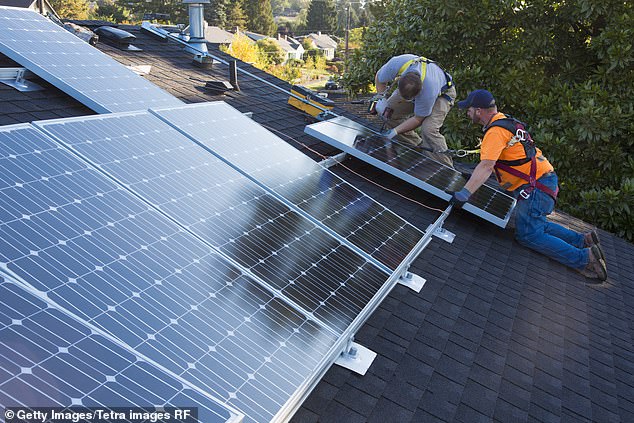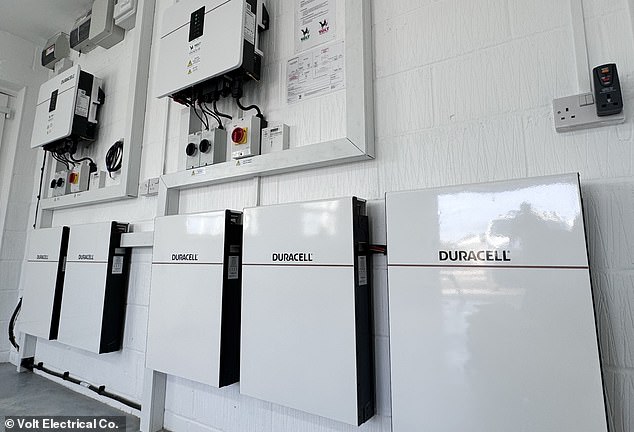Table of Contents
Homeowners could save up to £796 a year on their energy bills by installing a battery storage system in their home, according to The Energy Savings Trust.
For a three-bedroom home, with average energy prices, this could equal up to 85 percent of your energy costs.
While solar panels alone can save a typical household around £310 each year, battery storage systems allow the energy transferred from sunlight to be stored for use at night.
Saving Money: While battery storage systems can have considerable upfront costs, they allow homeowners to save large amounts on their electricity bills.
Using solar panels alone will save homeowners about 30 percent on their energy bill, according to Mark Millar, CEO of battery maker Puredrive Energy.
He said: ‘The average home (with solar panels) consumes 10 kilowatt hours of energy per day, except only 30 per cent of the energy is absorbed in the home because we generate during the day but use energy in the evenings and mornings.
“The remaining 70 percent of the energy goes to the grid, so the owner doesn’t see any benefit in it.”
According to Millar, adding a battery system allows this energy that would otherwise be wasted to be stored and used overnight and potentially the next morning, increasing savings to 60 percent.
While some 1.4 million homes in the UK have solar panels, around 4.9 per cent of the population, only 43 per cent of those with solar panels, or 602,000, also have a home battery.
More modern systems, however, can take advantage of variable tariffs to store energy when it is cheap, for use during periods when it is more expensive. This, Millar said, is what can generate savings of up to 85 percent.
“It’s a big change that’s really happened over the last year or two,” Millar said. “Some energy companies offer agile tariffs where the price of energy changes every hour or so… if you have a smart battery, then it will know when rates increase.” cheap and discharges energy when rates are high.’
Puredrive makes Duracell Energy’s new Dura 5 home battery. The product competes with companies like Tesla and Sunsynk, which also offer home storage systems.
Installing a battery storage system in your home could help you reduce your bills, but according to Puredrive it can also allow you to stop paying energy bills altogether.
By combining solar panels, a home battery and an air heat pump, homeowners can create a system that does not require anything from the grid, the company said.
Currently, those with new homes can achieve “zero bills,” Millar said, by combining these technologies with selling their excess energy to the grid during peak hours.

Complete system: Installing solar panels in conjunction with a home battery and heat pump will require considerably higher costs than battery-only installations.
Homeowners can use the Government’s Smart Export Guarantee to sell their excess energy. The SEG tariff replaced the Feed-in Tariff scheme, which closed in 2019.
“Regional network operators will give you money if you support the network,” he told Money. “If you’re watching Manchester United against Liverpool, at half-time the kettles go on and there’s an increase in usage. They pay you money to be able to maintain the network, and when you combine this with your home technology, the goal is to reach to zero bills.”
How much could this technology cost you?
The cost of installing a solar system can vary greatly depending on the products you plan to install, as well as the type of property you plan to install on.
Typically, installing a complete system consisting of an air source heat pump, solar panels and a home battery could cost homeowners £20,000 according to data from EcoQuoteToday, or £12,500 with the Government’s discount of £ 7500 in the boiler upgrade plan.
Millar said this figure is largely made up of installation costs, meaning that if the technology is installed during the construction process, this could be much less.
He said: “If you put them up when you build a house, then you already have scaffolding to put up the roof, so the solar panels can be installed at the same time.” Cables can also be added during the construction process.’
“We’re talking about £4,000 for any new home; if you were to install this technology in an existing home, an installer would charge you around £12,000.”
Battery-only installations increase
For many, the cost of installing batteries, heat pumps and solar panels could be well beyond their home improvement budget.
However, Millar says battery-only installations are becoming more popular because they have a simple installation process that can dramatically reduce costs compared to a full installation.
“The recovery is much faster,” he said. ‘If you charge the battery when it is cheap, paying 8p instead of 30p per kilowatt hour, you will save significantly.
“A couple of times a day the power will cost just 5p, the batteries can be charged during that time and then use the power throughout the day.”
Just to install a battery, owners can expect to pay between £4,000 and £5,000.
However, Millar points out that purely battery-powered facilities cannot give homeowners independence from the grid. He said, ‘That’s the difference you know from a philosophical perspective. It will be cheaper now, but will it be cheaper next year or the year after that? That depends on the energy supplier.’
Some links in this article may be affiliate links. If you click on them, we may earn a small commission. That helps us fund This Is Money and keep it free to use. We do not write articles to promote products. We do not allow any commercial relationship to affect our editorial independence.

